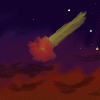
All tolled, this project went pretty smoothly, from posing and construction all the way up to the coloring. Can you believe I'm still not out of Beastfolk races?
The soldiers depicted are Opolchenie, a sort of inexpensive national militia lacking in professional equipment and training, but girded by bravery and racial solidarity. Their quantity amply compensates for their quality.
The Patkani are a race of rat humanoids living on the verdant southern frontier of the Beastfolk Alliance. Despite the richness of their land, however, they are a people historically afflicted by famine, which plays a central role in their racial culture, their history, and even their individual outlook on mortality.
The Patkani are small in stature, short-lived, and have a high metabolism that fuels apocalyptic desperation whenever their burgeoning population outstrips its food supply. Only the occupation and administration of their Kingdoms by the Vucari have held famine at bay, thanks to strict population control measures enacted by the lupines. Another benefit to foreign occupation has been industrialization, as the labor pool is cheap and virtually bottomless.
Yet the Patkani chafe under Vucari rule. They know that their king is a mere puppet, that their rule is far from benevolent, and that not very long ago the Vucari were more than willing to sell their people into slavery. Many are grateful for the modernization of their hectic state, but not the loss of their freedom.
For now, the Patkani remain loyal to the Alliance and the Vucari. Despite their hunger for autonomy, they know that membership in the Alliance protects them from another threat, that of the Caliphate of Man, who 150 years ago nearly plunged Patkania into bloody oblivion in a brutal religious crusade.
The soldiers depicted are Opolchenie, a sort of inexpensive national militia lacking in professional equipment and training, but girded by bravery and racial solidarity. Their quantity amply compensates for their quality.
The Patkani are a race of rat humanoids living on the verdant southern frontier of the Beastfolk Alliance. Despite the richness of their land, however, they are a people historically afflicted by famine, which plays a central role in their racial culture, their history, and even their individual outlook on mortality.
The Patkani are small in stature, short-lived, and have a high metabolism that fuels apocalyptic desperation whenever their burgeoning population outstrips its food supply. Only the occupation and administration of their Kingdoms by the Vucari have held famine at bay, thanks to strict population control measures enacted by the lupines. Another benefit to foreign occupation has been industrialization, as the labor pool is cheap and virtually bottomless.
Yet the Patkani chafe under Vucari rule. They know that their king is a mere puppet, that their rule is far from benevolent, and that not very long ago the Vucari were more than willing to sell their people into slavery. Many are grateful for the modernization of their hectic state, but not the loss of their freedom.
For now, the Patkani remain loyal to the Alliance and the Vucari. Despite their hunger for autonomy, they know that membership in the Alliance protects them from another threat, that of the Caliphate of Man, who 150 years ago nearly plunged Patkania into bloody oblivion in a brutal religious crusade.
Category Artwork (Digital) / Fantasy
Species Rat
Size 1080 x 1232px
File Size 269.5 kB
They need THICK WINTER COATS though. Or is their homeland not also defended from invasion by sheer cold?
Issue axes makes me wonder if their issue munitions were 'bar' shot, such as was used by the Turks for some time in the 17th and 18th c. Notched lead cylindrical bars from which one chopped rounds.
Issue axes makes me wonder if their issue munitions were 'bar' shot, such as was used by the Turks for some time in the 17th and 18th c. Notched lead cylindrical bars from which one chopped rounds.
Patkania is far enough to the south that the really awful cold isn't as significant a problem, though they have rather snowy winters. Generally, cloth for garments is in ample supply-- especially now that they're involved in textile milling.
As for the hatchets, I mainly presumed that they would be practical working tools as well as impromptu weapons, but the idea of bar shot isn't such a bad one. I hadn't heard of that practice before, honestly.
As for the hatchets, I mainly presumed that they would be practical working tools as well as impromptu weapons, but the idea of bar shot isn't such a bad one. I hadn't heard of that practice before, honestly.
It didn't last very long, in historical terms. Shot-towers and other means of mass-producing ball for large musket-equipped forces supplanted it in the parts of the world where it did see use fairly rapidly. But at one point it was a simple means of 'getting more lead out' to armies which were just beginning to equip all soldiers with muskets. Going from a situation where troops often brought their own weapons (bows, blades) to one where the ruler owned and issued new-fangled smokepoles was a real logistics nightmare. It was still a logistics nightmare as late as the late 18th c. when officers would frequently bring their own 'fowling pieces' rather than use the issue musket.
Of course, said officer was far more likely to have his own mold for ball.
Of course, said officer was far more likely to have his own mold for ball.
I actually factored in the logistical problems inherent to an army in transition from feudal to modern warfare-- it's the main reason the White Jihad, the last and latest of the Caliphate's great wars, fell flat on its face.
Previous Jihads had been affairs of swordsmen and horsemen backed by levy troops armed with whatever weapons they brought. In the age of muskets, however, this old system simply couldn't cope- the Caliph was forced into a predicament where there was a need for a vast quantity of firearms, shot, and powder but little industrial production of those items. Add to that the logistical nightmare of supplying an army on the other side of a very rugged mountain range and you've got trouble.
The Patkani were neither terribly modern or skilled, but they were very close to their supply lines and fought with equal, if not greater zeal than the Jihadis. They fought the Humans to a standstill, and afterwards time, winter, and disease took care of the rest.
Previous Jihads had been affairs of swordsmen and horsemen backed by levy troops armed with whatever weapons they brought. In the age of muskets, however, this old system simply couldn't cope- the Caliph was forced into a predicament where there was a need for a vast quantity of firearms, shot, and powder but little industrial production of those items. Add to that the logistical nightmare of supplying an army on the other side of a very rugged mountain range and you've got trouble.
The Patkani were neither terribly modern or skilled, but they were very close to their supply lines and fought with equal, if not greater zeal than the Jihadis. They fought the Humans to a standstill, and afterwards time, winter, and disease took care of the rest.
Well done.
Of course, in the earliest stages of black-powder, anyone who could create even a single company of drilled and equipped (and logistically sustainable) tufekci had one hell of an advantage on the battlefield. Even cavalry horses trained not to balk at the occasional sporadic shot by the rider were apt to bolt when confronted with a coordinated and simultaneous volley.
Presuming they survived the volley.
As usual you've put a lot of thought into this, and it becomes more apparent the more you post. :)
Of course, in the earliest stages of black-powder, anyone who could create even a single company of drilled and equipped (and logistically sustainable) tufekci had one hell of an advantage on the battlefield. Even cavalry horses trained not to balk at the occasional sporadic shot by the rider were apt to bolt when confronted with a coordinated and simultaneous volley.
Presuming they survived the volley.
As usual you've put a lot of thought into this, and it becomes more apparent the more you post. :)
Very impressive. I have a crush for rats anyway, but I especially like the uniform design. Appears to me as a mixture of Russian and Balkan/Turkish, which is very fitting for a rodent species living in the south. The officer's cap looks badass, and the soldier's appear quite Ottoman...
All I have to post yet is http://www.youtube.com/watch?v=eH6fjBUd3KY
All I have to post yet is http://www.youtube.com/watch?v=eH6fjBUd3KY
I sort of imagined the one on the left as a corporal, or possibly even a sergeant-- a non-commissioned officer. That sort of explains why his musket is held together with baling wire and his coat has seen better days. Back in that era, non-commissioned officers were treated little better than the infantry beneath them-- even today, a lot of armies in the developing world are victims of this thinking, since many nations still have two social strata: the rich and the poor.
It was quite common that many officers and military leaders were hardly better then mercenaries, traveling through Europe and joining the wars, even changing sides when they thought it was necessary. Many have been adventurers and noble characters, like the generals of Maria Theresia in the seven years war, but naturally there have been others as well.
Besides, I highly appreciate your efforts into detail... Detail is so important, I am very glad to find someone else who likes to think about such things...
Besides, I highly appreciate your efforts into detail... Detail is so important, I am very glad to find someone else who likes to think about such things...
The Patkani are the only rodent humanoids in the universe, but there are dozens of races. You may not guess it from the story of the Patkani, but the Humans and their nation-state are surprisingly open minded and cosmopolitan when it comes to other species. They have to be- they're practically swimming in Elves, Orcs, and Beastfolk.

 FA+
FA+




















Comments